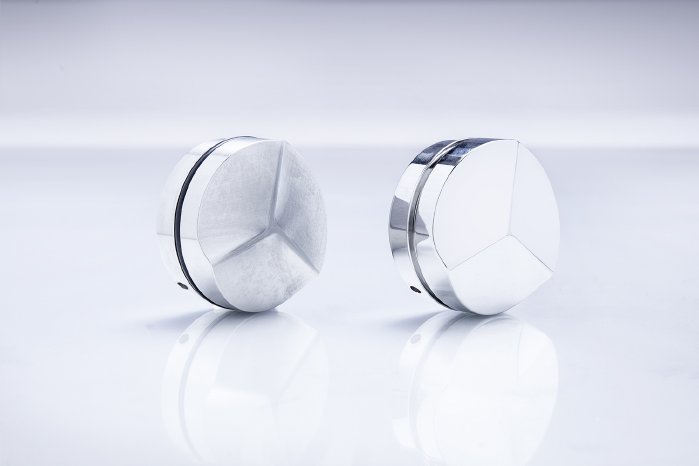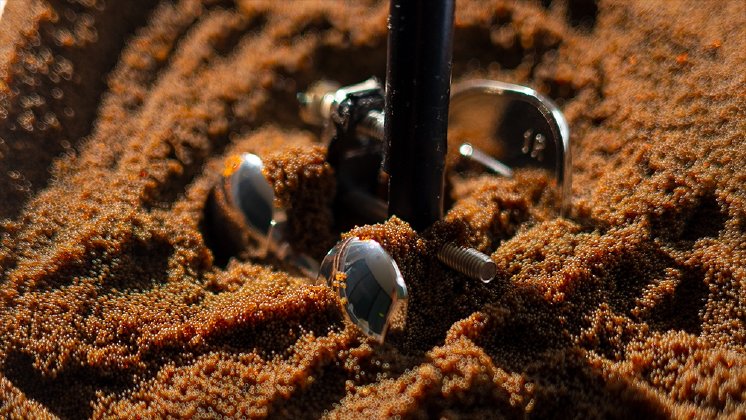Whether for cosmetic or functional reasons – the providers of surface finishing solutions are confronted with numerous challenges. On the one side demands for lower surface roughness values and geometrical consistency of the finished work pieces must be met, whereas on the other side the finishing processes must be cost-efficient and eco-friendly. Issues such as energy requirements, consumption of valuable resources, prevention of potentially hazardous substances and waste disposal are becoming more important. In addition, the customers are demanding absolutely consistent results and processes that can be perfectly reproduced. All these requirements can only partially be met with manual finishing or traditional electropolishing methods with liquid electrolytes. With its innovative DryLyte polishing technology GPA Innova, a partner of Rösler Oberflächentechnik, offers an excellent method for finishing geometrically complex components made from conductive metals.
From deburring to high gloss polishing – a sustainable and highly efficient technology
The fully automatic DryLyte system simplifies and helps standardize different surface finishing tasks such as deburring, surface smoothing, surface grinding, high gloss polishing and, even, post processing of 3D printed components. Depending on the initial surface conditions und the specified finishing results, dry electropolishing can be utilized as stand-alone process or in combination with known mass finishing, shot blasting and other pre-grinding methods.
The DryLyte technology is based on the principle of electro-chemical material removal from the surface of components. However, the technology does not use liquid electrolytes but a multitude of polymer pellets in different sizes containing electrolyte media that are precisely adapted to the respective finishing task. In contrast to the traditional electropolishing systems no hazardous vapors are generated requiring energy-intensive exhaust systems and special protective gear for the operator. Since the material removed from the work piece surface is absorbed by the electrolyte medium, no dust or metal particles are getting into the environment, as happens with manual grinding and polishing operations. High-quality, consistent processing results are achieved throughout the usable life of the electrolyte medium. This must only be replaced once the dry electrolyte has been saturated with the metal removed from the work piece surface. The waste disposal of the saturated electrolytes is similar to the disposal of grinding media. The saturation rate is monitored by the machine so that the operator is always up-to-date and informed about the remaining usage time. This guarantees absolutely stable, and consistent finishing results and the optimal utilization of the electrolyte. It also helps minimize the costs for labor and waste disposal. Finally, because of the efficient resource utilization the CO2 footprint is reduced..
A precise and gentle finishing process that maintains the geometrical integrity of the work pieces
During the dry electropolishing process the work pieces, mounted to a fixture, are slowly moving through the dry electrolyte. This ensures complete coverage of the entire surface. If required, internal surface areas can also be finished by using special electrodes. The DryLyte method removes primarily the roughness peaks from the surface. Therefore, the metal removal rate is minimal, and the overall process is very gentle. The finished work pieces have a highly homogeneous surface with no pressure points or an orange peel effect. Even in the case of delicate work pieces with complex shapes no damage in the form of scratches or breakage occurs.
The targeted and “controlled” processing ensures that in case of precision components like machining tools or tools for the pharmaceutical industry their geometrical integrity is not affected, and their edges are not radiused. In addition, the highly effective smoothing effect on the surface prevents micro cracks and pitting. This improves the corrosion resistance and “fatigue” characteristics and, thus, extends the usable life of the components. Compared to components treated with traditional electropolishing, dry-electropolished components corrode 4 to 15 times slower as proven in corrosion tests in a saltwater solution containing 30 grams/liter NaCL. In the case of gear components used in mechanical systems, dry electropolishing increases the material load ratio, reduces friction and guarantees the optimal distribution of lubricants on the work piece surface. The improved surface conditions result in a lower wear rate and, at the same time, reduce the noise level.
Another significant benefit of the DryLyte technology are the relatively short cycle times. Depending on the finishing application, initial surface roughness and required results, they can vary between a few minutes and 1.5 hours. The process creates not only a smoother surface but, if needed it can also produce a high gloss polish in one single process. For post processing of 3D printed components with their typically very high surface roughness, the electropolishing operation is preceded by a mass finishing process utilizing abrasive grinding media.
Easy adaptation to many finishing applications
The unique, patented dry electropolishing technology was initially developed for finishing prototype castings and dental crowns made from cobalt chrome and titanium. In the meantime the dry electropolishing method from GPA Innova is used for finishing stainless steel, steel, hard metals as well as nickel, aluminum and copper alloys along with other conductive metals. Today the process is used whenever high finishing qualities are required in industries such as aerospace, pharmaceutical, machine building as well as luxury and consumer goods. Because of the proven biocompatibility of the finished components dry electropolishing is also used in medial engineering for the production of implants and instruments.
Process development and definition of the process parameters for the respective finishing application takes place in the customer experience center at Rösler. For this purpose, the CEC is equipped with different machine types allowing fully automatic operation. This approach guarantees that the finishing processes for the customer components are always based on precisely defined and validated parameters.
www.rosler.com



